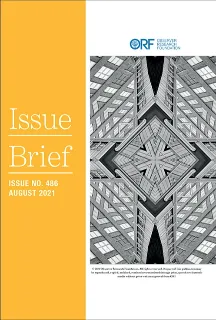Putting a stop to Iran’s weapons activities is not an easy task. First of all, Iran is not a weak state run by a personalist regime. Its weapons project is also now in the advanced stage, suggesting that its scientists do not suffer from issues like political meddling.[47] Facing nuclear-weapons states like Israel and the US as adversaries, Iran is definitely not constrained by non-proliferation norms. It does not have a protective ally which can threaten abandonment or a potential ally willing to offer security guarantees.
The best possible route to constraining Iran’s nuclear ambitions is a multilateral sanctions regime, like the one which led to the JCPOA. A resumption of JCPOA, or the forging of a new JCPOA-type agreement, could delay Iran’s nuclear pursuit.[48] Such delay can lead to a complete forgoing of nuclear weapons in the long term. This could happen if at the end of JCPOA’s term Iran’s threat perception declines, or if by then it has developed economic ties with other countries which it would fear losing if it resumes the weapons project.[49]
To be sure, economic sanctions and diplomatic negotiations do not rule out military attacks if Iran refuses to cooperate. Yet, as argued in this brief, the use of military force can eliminate the possibility of diplomatic negotiations. The use of force, in the best-case scenario, achieves the same result as JCPOA did: cause a delay in Iran’s nuclear pursuit. It is unlikely to coerce Iran into renouncing the bomb entirely. On the other hand, in the worst-case scenario, use of force might lead to either an accelerated Iranian pursuit for the bomb or a full-fledged war, or both.
About the Author
Kunal Singh is pursuing a PhD in political science at the Massachusetts Institute of Technology. Views are personal.
Endnotes
[1] Ronen Bergman, Rick Gladstone, and Farnaz Fassihi, “Blackout Hits Iran Nuclear Site in What Appears to Be Israeli Sabotage,” The New York Times, April 11, 2021, sec. World; Jon Gambrell, “EXPLAINER: Iran Atomic Sites Targeted by Diplomacy, Sabotage,” AP NEWS, April 12, 2021, sec. Reza Pahlavi.
[2] Peter Beaumont, “Netanyahu Denounces Iran Nuclear Deal but Faces Criticism from within Israel,” The Guardian, July 14, 2015, sec. World news.
[3] Zoe Kleinman, “Mohsen Fakhrizadeh: ‘Machine-Gun with AI’ Used to Kill Iran Scientist,” BBC News, December 7, 2020, sec. Middle East.
[4] Farnaz Fassihi, “Major Explosion Rocks Iran Again, the 3rd Blast in 3 Weeks,” The New York Times, July 10, 2020, sec. World.
[5] Anchal Vohra, “Israel’s Attacks on Iran Are Not Working,” Foreign Policy, April 27, 2021.
[6] “Official: Israel Upgrading Contingency Plans for Iran Attack,” AP NEWS, March 5, 2021, sec. Middle East.
[7] Jonathan Lis, “Bennett at AIPAC: Iran Deal an ‘unmitigated Disaster’ of Historic Proportions,” Haaretz, March 2, 2015; “Israel’s New Foreign Minister Says He Will Do Everything To Stop Iran Nukes,” Iran International, June 14, 2021.
[8] John R. Bolton, “Opinion | To Stop Iran’s Bomb, Bomb Iran,” The New York Times, March 26, 2015, sec. Opinion; Matthew Kroenig, “Time to Attack Iran,” Foreign Affairs, February 2012.
[9] Alexandre Debs and Nuno P. Monteiro, Nuclear Politics: The Strategic Causes of Proliferation (Cambridge: Cambridge University Press, 2017).
[10] Nuno P. Monteiro and Alexandre Debs, “The Strategic Logic of Nuclear Proliferation,” International Security 39, no. 2 (October 2014): 7–51.
[11] Robert F. Trager and Lynn Vavreck, “The Political Costs of Crisis Bargaining: Presidential Rhetoric and the Role of Party,” American Journal of Political Science 55, no. 3 (2011): 526–45.
[12] George Simmel, Conflict And The Web Of Group Affiliations (Simon and Schuster, 2010); Douglas M. Gibler, “Outside-In: The Effects of External Threat on State Centralization,” The Journal of Conflict Resolution 54, no. 4 (2010): 519–42.
[13] Paul Huth, Standing Your Ground: Territorial Disputes and International Conflict (Ann Arbor: University of Michigan Press, 1998); Paul D. Senese and John A. Vasquez, The Steps to War: An Empirical Study (Princeton: Princeton University Press, 2008).
[14] Thomas C. Schelling, Arms and Influence (New Haven : Yale University Press, 2008., 2008); Robert A. Pape, Bombing to Win: Air Power and Coercion in War, 1st edition (Ithaca, N.Y: Cornell University Press, 1996).
[15] Schelling, Arms and Influence., p. 74.
[16] Vohra, “Israel’s Attacks on Iran Are Not Working.”
[17] Noble Frankland, Bomber Offensive: The Devastation of Europe, First Edition (New York: Ballantine Books, 1970)., p. 73-75
[18] Matthew Fuhrmann, “When Preventive War Threats Work for Nuclear Nonproliferation,” The Washington Quarterly 41, no. 3 (July 3, 2018): 111–35.
[19] “Iran Is Building Something New at an Underground Nuclear Site,” CBS News, December 18, 20202.
[20] Jim Zanotti et al., “Israel: Possible Military Strike Against Iran’s Nuclear Facilities” (Congressional Research Service, September 28, 2012).
[21] Dan De Luce, “Killing of Scientist Won’t Derail Iran’s Nuclear Program, Experts Say,” NBC News, December 1, 2020.
[22] For a review of the literature on audience costs, see Susan D. Hyde and Elizabeth N. Saunders, “Recapturing Regime Type in International Relations: Leaders, Institutions, and Agency Space,” International Organization 74, no. 2 (ed 2020): 363–95.
[23] For a discussion on what makes a country capable of making nuclear weapons, see Stephen M. Meyer, The Dynamics of Nuclear Proliferation (Chicago: Chicago University Press, 1984., 1984); JR Stoll, “World Proliferation of Latent Nuclear Capacity,” 1996; Dong-Joon Jo and Erik Gartzke, “Determinants of Nuclear Weapons Proliferation,” The Journal of Conflict Resolution 51, no. 1 (2007): 167–94; Matthew Fuhrmann and Benjamin Tkach, “Almost Nuclear: Introducing the Nuclear Latency Dataset,” Conflict Management and Peace Science 32, no. 4 (September 1, 2015): 443–61.
[24] The list of 29 states is obtained from Vipin Narang, “Strategies of Nuclear Proliferation: How States Pursue the Bomb,” International Security 41, no. 3 (January 2017): 110–50.
[25] Amos Harel and Aluf Benn, “No Longer a Secret: How Israel Destroyed Syria’s Nuclear Reactor,” Haaretz, March 23, 2018.
[26] George W. Bush, Decision Points, Illustrated edition (New York: Crown, 2011).
[27] “Israel Admits Striking Suspected Syrian Nuclear Reactor in 2007,” BBC News, March 21, 2018, sec. Middle East.
[28] Rodger Claire, Raid on the Sun: Inside Israel’s Secret Campaign That Denied Saddam the Bomb, Reprint edition (New York: Crown, 2005).
[29] Nicholas D. Kristof, “Opinion | The Osirak Option,” The New York Times, November 15, 2002, sec. Opinion.
[30] Målfrid Braut-Hegghammer, “Revisiting Osirak: Preventive Attacks and Nuclear Proliferation Risks,” International Security 36, no. 1 (July 1, 2011): 101–32, p. 112.
[31] Dan Reiter, “Preventive Attacks Against Nuclear Programs And The ‘Success’ At Osiraq,” The Nonproliferation Review 12, no. 2 (July 2005): 355–71.
[32] Braut-Hegghammer, “Revisiting Osirak.”, p. 116.
[33] For the two contrasting views on Iraq’s progress towards the bomb by the Gulf War, see Jacques E. C. Hymans, Achieving Nuclear Ambitions : Scientists, Politicians and Proliferation (Cambridge ; New York : Cambridge University Press, 2012., 2012); Målfrid Braut-Hegghammer, Unclear Physics : Why Iraq and Libya Failed to Build Nuclear Weapons, Cornell Studies in Security Affairs (Ithaca : Cornell University Press, 2016., 2016).
[34] Shai Feldman, “The Bombing of Osiraq-Revisited,” International Security 7, no. 2 (1982): 114–42. p. 141.
[35] Kim Zetter, Countdown to Zero Day: Stuxnet and the Launch of the World’s First Digital Weapon, Reprint edition (New York: Crown, 2015); David E. Sanger, Confront and Conceal: Obama’s Secret Wars and Surprising Use of American Power, Updated edition (Crown, 2012).
[36] Yaakov Katz, “‘Stuxnet Virus Set Back Iran’s Nuclear Program by 2 Years,’” The Jerusalem Post | JPost.Com, December 15, 2010.
[37] Paul Roberts, “New York Times: Stuxnet A Joint US-Israeli Operation,” January 16, 2011.
[38] Ivanka Barzashka, “Are Cyber-Weapons Effective?,” The RUSI Journal 158, no. 2 (April 1, 2013): 48–56.
[39] Barzashka., p. 54.
[40] Scott D. Sagan, “Why Do States Build Nuclear Weapons?: Three Models in Search of a Bomb,” International Security 21, no. 3 (1996): 54–86.
[41] Mitchell Reiss, Bridled Ambition : Why Countries Constrain Their Nuclear Capabilities. (Washington, D.C., U.S.A. : Woodrow Wilson Center Press; c1995., 1995); For nuclear taboo, refer to Nina Tannenwald, “The Nuclear Taboo: The United States and the Normative Basis of Nuclear Non-Use,” International Organization 53, no. 3 (1999): 433–68.
[42] Francis J. Gavin, “Strategies of Inhibition: U.S. Grand Strategy, the Nuclear Revolution, and Nonproliferation,” International Security 40, no. 1 (July 2015): 9–46.
[43] Philipp C. Bleek and Eric B. Lorber, “Security Guarantees and Allied Nuclear Proliferation,” The Journal of Conflict Resolution 58, no. 3 (2014): 429–54; Bruno Tertrais, “Security Guarantees and Nuclear Non-Proliferation” (Fondation pour la Recherche Stratégique), accessed June 25, 2021; T. V. Paul, Power Versus Prudence : Why Nations Forgo Nuclear Weapons, First edition (Montreal ; Ithaca, N.Y: McGill-Queen’s University Press, 2000); Gene Gerzhoy, “Alliance Coercion and Nuclear Restraint: How the United States Thwarted West Germany’s Nuclear Ambitions,” International Security 39, no. 4 (April 1, 2015): 91–129; David Albright and Andrea Stricker, Taiwan’s Former Nuclear Weapons Program: Nuclear Weapons On-Demand (Institute for Science and International Security, 2018).
[44] Hymans, Achieving Nuclear Ambitions.
[45] Braut-Hegghammer, Unclear Physics.
[46] Nicholas L. Miller, Stopping the Bomb : The Sources and Effectiveness of US Nonproliferation Policy (Ithaca : Cornell University Press, 2018., 2018).
[47] Sune Engel Rasmussen and Laurence Norman, “Iran’s Nuclear Program: How Close Is Tehran to Developing Nuclear Weapons?,” Wall Street Journal, April 16, 2021, sec. World.
[48] This was one of the criticisms of the JCPOA that its provisions allowed Iran to develop the nuclear bomb after a delay. For the provisions of the JCPOA, see Kelsey Davenport, “The Joint Comprehensive Plan of Action (JCPOA) at a Glance | Arms Control Association,” March 2021.
[49] Etel Solingen, Nuclear Logics : Contrasting Paths in East Asia and the Middle East., Nuclear Logics : Contrasting Paths in East Asia and the Middle East / Etel Solingen., 2007.

 PDF Download
PDF Download



 PREV
PREV


